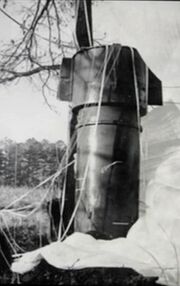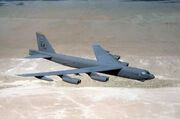
One of the Mk 39 nuclear weapons at Goldsboro, largely intact, with its parachute still attached. Close up of one of two Mk.39 thermonuclear bombs rests in a field in Faro, NC after falling from a disintegrating B-52 bomber in an incident known as the "1961 Goldsboro B-52 crash."
Stats[]
- Date- January 24, 1961.
- Cause of accident- The aircraft's structural failure.
- Site- Faro, Nahunta Township, Wayne County, 12 miles (19 km) north of Goldsboro, North Carolina: 35.493041°N 77.859262°W .
- Crew- 8.
- Fatalities- 3.
- Survivors- 5.
- Aircraft type- B-52G.
- Operator- Strategic Air Command, United States Air Force.
- Registration- 58-0187.
- Flight origin- Seymour Johnson Air Force Base.
- Destination- Seymour Johnson Air Force Base.
- Victim nation- USA.
The crash[]

A B-52H from Barksdale AFB flying over the desert.
It was a Cold War era B-52 Stratofortress bomber air crash in North Carolina, USA that almost caused a nuclear accident.
A fuel leak occurred as they refuelled from a tanker aircraft. By the time the B-52 reached its assigned fight position, the pilot reported that the leak had significantly worsened and that 37,000 pounds (17,000 kg) of fuel had been lost over the previous 3 minutes. They were ordered to land immediately at Seymour Johnson Air Force Base.
As they descended by 10,000 feet (3,000 m) on their approach to the airfield, the pilots were found they were no longer able to keep the aircraft in trim, felt it's controls being to go in to rapid decline and lost control of the aircraft.
The pilot in command ordered the crew to eject, which they did at 9,000 feet (2,700 m) and the bomber crashed.
The aftermath[]
Domestic issues[]
Both Mk39 atomic bombs had a yield of 3.8mt and used the W39 warhead. The did not go off. They were used between 1957 and 1966.
The first bomb stayed largely above ground and the safe/arm switch was the only one of the 6 arming devices on the bomb that prevented detonation.
Excavation of the berried second bomb was abandoned in 1961 as a result of uncontrollable ground-water flooding. Most of the thermonuclear stage, containing uranium, was left in place, 20 feet (6.1 m) below ground. It was fully armed and only failed to go off due to good luck until the excavation crew deactivated it in 1961, according to documents that were declassified in 2013. The ground was bought and fenced of by the American military.
East/West diplomacy[]
Both the USA and USSR were scared witless by both this and the earlier Soviet Kyshtym (Urals Mountains) disaster, so they held a summit on atomic power station safety, atomic waste storage safety, nuclear weapons safety and post-disaster co-operation later in 1961.
Also see[]
- Atomic accidents and disasters
- 1966 Palomares B-52 crash
- 1968 Thule Air Base B-52 crash
- Operation Chrome Dome
- 1960 Bomarc Missile accident
- A nuclear\atomic holocaust or nuclear apocalypse
- 1961 Yuba City B-52 crash
- 1964 Savage Mountain B-52 crash
- Noteworthy Air bases
Links[]
- http://en.wikipedia.org/wiki/1961_Goldsboro_B-52_crash
- http://www.ibiblio.org/bomb/
- http://www.restorationsystems.com/uncategorized/whoops-atomic-bomb-dropped-in-goldsboro-nc-swamp-neuse-huc-02/
- http://www.theguardian.com/world/interactive/2013/sep/20/goldsboro-revisited-declassified-document
- http://www.ibiblio.org/bomb/ease.html
- https://readtiger.com/wkp/en/1961_Goldsboro_B-52_crash
- http://military.wikia.com/wiki/1961_Goldsboro_B-52_crash